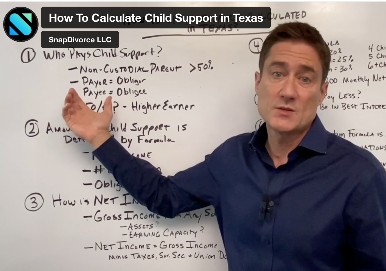
How Does Joint Custody Work After Divorce?
Divorce can be scary for children. It can be equally frightening for parents who don’t know how custody arrangements work after divorce. While life as a single parent may have its challenges, post-divorce parenting can be far less daunting when you know what to expect in terms of legal decision-making, scheduling, child exchanges, and resolving conflicts in a custody setting.
The Basics: Legal vs. Physical Custody
Courts divide parenting duties into two broad categories: legal custody and physical custody.
Legal Custody entitles parents to make important decisions about their child’s medical, educational, and religious well-being. Courts prefer parents to share responsibility for making choices in these critical areas. As a result, legal custody is rarely granted to only one parent. Mom and dad should plan on putting aside their differences so that they can make these important decisions together in a way that will be in their child’s best interest.
Physical Custody refers to the schedule or blocks of time a child spends in the physical presence of each parent (i.e. when a parent has the right to see their children). Typically, the physical custody schedule is set forth in detail in a custody agreement or court order.
Traditionally, fathers often found their parenting time limited to every other weekend and a weekly dinner visit. Today, however, many parents recognize the benefits of sharing parenting time more evenly. Active engagement by both parents reminds children they are still loved and that two people—not one—remain committed to ensuring that they flourish in life. Today, custody orders often reflect this thinking.
Whose Day Is It Anyway? Creating a Basic Physical Custody Schedule
Parents can tailor a physical custody plan to suit their family’s unique needs by reaching an agreement. If they can’t agree, then the court will impose a schedule. Many parents of younger children use a “2-2-3” custody arrangement that has children moving between parents every two to three days. The advantage of this format is that youngsters are not separated from either parent for too long a period. Additionally, over a two-week period, each parent gets to enjoy a long weekend with the children.
When children are a bit older, many families prefer to alternate physical custody on a weekly basis. This schedule reduces the inconvenience of frequent child exchanges and encourages increased stability because both parents and children have time to “settle into” a more normal family routine in each household.
Ultimately, whether it’s the traditional “every other weekend” arrangement or something closer to a 50/50 situation, families should seek a schedule that allows both kids and parents to grow strong and loving bonds following the divorce.
Holiday Happiness or Horror: How Special Days Get Divided
Dividing up holidays can be one of the more emotional issues in negotiating a post-divorce custody schedule. Sometimes long-standing holiday traditions must give way to new realities. This can prove painful for parents and children alike. The most successful holiday schedules respect both parents’ desire to create new, happy memories with their children—while not making children feel caught in a never-ending game of tug-of-war.
When determining a holiday custody schedule, the court usually grants physical custody to a parent on alternating major holidays, which include New Years’ Day, Easter or Passover, Memorial Day, July 4th, Labor Day, Thanksgiving, Christmas Eve, Christmas Day, and New Years’ Eve. Less prominent holidays such as Columbus Day and Veterans Day may be either included in the list of alternating holidays or simply allowed to fall under the general custody schedule. Of course, Mother’s Day and Father’s Day are always spent with the appropriate parent. Parents rotate through all the holidays on a two-year cycle, celebrating half in even numbered years and the remainder in odd numbered years.
In amicable divorces, a spirit of flexibility empowers some divorcing parents to find creative ways to share holiday time and preserve traditions that maintain the family’s sense of stability. Such approaches can include sharing every holiday by incorporating mid-day custody exchanges. In the end, the best arrangement is one on which everyone can agree.
Dealing With Special Circumstances: The Backup Plan to the Plan
Sometimes the unexpected happens. A child gets injured on the soccer field. Dad’s car gets a flat on the way to a custody exchange. Mom wants to take the kids to her family reunion in Florida. A well-crafted custody agreement can and does plan for both the expected and unexpected.
For example, most custody orders grant one to two weeks of vacation time per year for each parent. Vacationing parents generally inform the other parent of travel plans thirty days or more in advance to reserve additional custodial time. Vacation usually trumps the regular custody schedule and gives each parent the opportunity to spend extended time with the children.
A well-craft custody agreement addresses less common events too, such as who makes decisions in a medical emergency or what happens if a parent can’t be present when he or she has physical custody. In these instances, the parent who has physical custody when an emergency arises generally makes decisions to stabilize the situation and then contacts the other parent as soon as reasonably possible. In a case where the parent assigned physical custody cannot be present for his or her custodial time, some agreements include a “right of first refusal,” where the non-custodial parent has the right to pick up extra custodial time, rather than have the child be passed off to a babysitter or other family member.
Cooperation or Contempt: Keeping Child Custody on Track
A well-thought out custody agreement itself can help reduce friction between parties who are learning the parameters of post-divorce parenting. For instance, custody exchanges can often be flashpoints, so an order should define who is responsible for drop off and pick up, where exchanges take place, and protocols for when a parent is late or unable to appear in person. In contentious divorces, exchanges often take place at a neutral locations such as at the child’s school or daycare, or even outside the local police department, if need be, to minimize conflict.
When common sense and the children’s best interests are not enough to encourage compliance, the court has tools to compel cooperation. If a parent violates a custody order and is found to be in contempt, the court can order fines up to $500, attorney’s fees, additional custodial time for the slighted parent, and even jail time in rare instances.
Litigating custody issues increases the pain of divorce. Children are caught between warring parents. Parents grow too alienated to co-parent peacefully. Anger and stress erode relationships all around. This doesn’t have to be the case. Custody matters can be determined cooperatively and creatively in a way to help divorcing parents reach the all-important goal of raising healthy, happy kids–even after a marriage comes to an end.
Related Articles

Don’t blow
everything for
the sake of
revenge.
Find out how SnapDivorce® can help you simplify your divorce.


